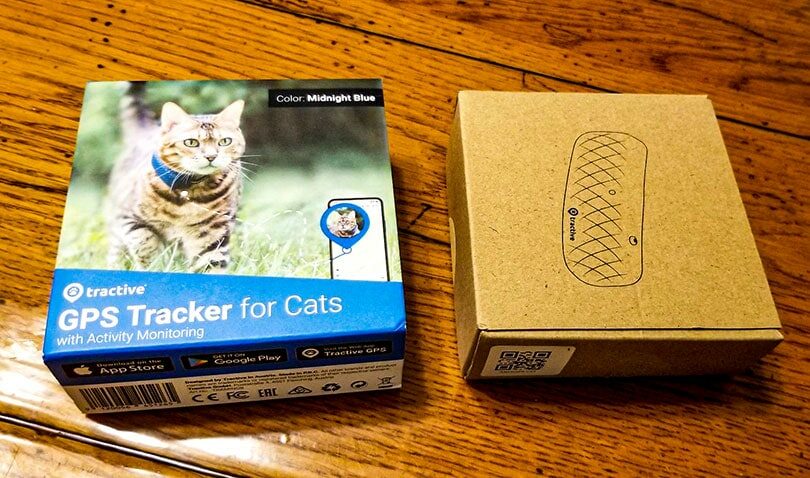Review Summary
We give Tractive GPS Tracker for cats a rating of 4.0 out of 5 stars.
What Is the Tractive GPS Tracker for Cats? How Does It Work?
The Tractive GPS Tracker for Cats is exactly what it sounds like: A collar with an on-board GPS tracker that tells you where your pet is! It also tracks where your cat has been over the past 365 days. With a 7-day battery life, the collar is waterproof, shock-resistant, and lightweight. Cat owners with a feline that goes on the run will love the LIVE feature that provides location updates every 2-3 seconds.
As you may guess, the Tractive GPS trackers require a subscription for data to provide updates to your devices. Tractive offers these plans as monthly subscriptions (most expensive), 1-year subscription paid up front (middle of the road), and 2-year subscriptions paid up front (least expensive). The SIM card provided works in 175+ countries, and is seamless with one subscription.

Where to Get Tractive GPS Trackers for Cats?
The best place to get the collar is on Tractive’s website. They are available through major retailers, but the manufacturer’s website allows you to purchase and activate your device in one place. I shopped around online and saw no difference in pricing.
Tractive GPS Tracker for Cats – A Quick Look
- Small and lightweight
- 7-day battery life
- SIM cellular connection provides location anywhere in 175+ countries
- LIVE mode gives updates every 2-3 seconds and heat maps let you see where your pet spends most of their time
- Activity and sleep monitoring
- Monthly subscription fee (small con, fees are low)
- Online reviews complain about unreachable tech support, tech support says it can take up to 5 days to get a response
Tractive GPS Tracker for Cats Pricing
The tracker itself retails online for $49.99 without a collar.
The tracker with the included collar costs $57.99. My unit did not come with a collar, but if I were going to order one in the future, I would get the one that had a collar just to make sure I had a collar that fit right. Thankfully, the unit fit my cat’s collar just fine. If I had to put it on a larger collar, a few zip ties in the right spots would secure it with no problem.
What to Expect from the Tractive GPS Tracker for Cats
I received the tracker in a standard shipping bag. The tracker itself is encased in a sturdy, attractive small box that clearly describes what it is and showcases set up and use with large photos and infographics. There are two small enclosures provided that fit on the collar and securely house the device itself, a USB charging cable, and clear diagrams depicting what to do on the inside of the box.

- Cost: $57.99
- Subscription fee: $5-$12/month, depending on how much time you buy up front
- Battery life: 7 days
- Requirements: You must supply your own USB charger
Quality
The Tractive GPS Tracker appears to be well made in a sealed plastic enclosure. I have a hard time seeing how a cat would break this! It is slim, lightweight, and curves to help match the curvature of a cat’s neck. The LED indicator lights are bright and easy to see when following directions in the manual, on the website, or in the app. The power button (the only button on the unit) is housed in a protective recess that should help prevent your cat from pressing it on their adventures.
Set Up
The Tractive GPS Tracker is easy to set up. I did it by downloading the app to my iPhone, but it can be set up on the website tractive.com as well. It took me a few minutes. The device does not come charged enough out of the box to set up, and needs to be charged for a couple of hours before setup.
Set up took me approximately 5 minutes, including the process to update the tracker itself from my phone. The device immediately activated and I could see its location on the map.

Location Accuracy
Location accuracy is not as good as my iPhone, which can tell me where I am accurately inside my home. While that kind of accuracy is cool, it’s not necessary for a device like this to work well. GPS devices are generally only accurate to within 2.1–6 feet even when all conditions are optimal. Don’t expect this to tell you that Fluffy is sitting right behind you, just that you’re in the correct general vicinity.
The tracker has two features to help you overcome these last few feet, however – a light and an alarm. You can use the app to activate a light on the front of the collar (quite bright at dusk or after dark!), or an alarm that repeatedly plays a very distinct series of tones. It isn’t very loud, but loud enough to hear several feet away outside after dark over most ambient sounds.
Battery Life
Tractive does not provide a charger with the tracker. The charge cable provided plugs into any standard USB charger. The portion of the charger that connects to the tracker is a little counterintuitive—it magnetically attaches to the unit but still needs to be snapped in. Be sure to follow this part of the directions in the Quick Start Guide! The device’s LED will glow solid red when charging, so it’s easy to know when you’ve got it connected correctly. Once charged, the LED turns green.
Battery life is pretty good as I tested it. I don’t know that it will last the full advertised seven days, but I’ve also used the LIVE feature quite a bit to test it, and I have noticed that it causes a much faster battery drain than normal.
Cellular Reception
I live in a very rural area with fairly spotty cell reception. The collar did pretty well, although there were times I loaded the map and it wasn’t able to find the tracker for several minutes. This is to be expected: If you can’t use your cell phone in an area, chances are you won’t have good performance from the tracker either. That said, as my pet moved around, I could see the tracker pop up on the map and get an idea of where my pet was and what direction they were headed.

Is the Tractive GPS Tracker for Cats a Good Value?
The value of the Tractive GPS Tracker is in the eye of the owner and is very dependent on the intended use. The tracker will not tell you where your pet is inside a 2-foot circle. If your pet is in a culvert or under a house or in a cellular dead zone, there will be no GPS connectivity and you’ll have to wait until they come out to see where they are.
If you want to know where your pet spends most of their time, or you want to know if they’re at the neighbor’s, or you know they tend to hide out in the yard or nearby when it’s time to come in and you want to know what side of the yard they’re hiding on and play an alarm to find them, it’s a great choice.
Is it worth the monthly subscription? For me, if I decided I needed this, it would be a long term decision and I would buy the 2 year plan to get the $5/month cost.
FAQ
What cellular carriers does the tracker use?
According to the manufacturer, the tracker uses AT&T, Verizon, T-Mobile, and other networks.
What is the maximum range for the tracker?
There is no maximum range. The tracker does not tether to your phone—it is an independent cellular device and delivers GPS location data over the cell network to your phone.
Can you set up geofencing and alerts if your cat strays outside a particular zone?
Yes. The app/website let you set up geofencing. You can have multiple geofences, and you will get an alert if your pet strays outside the fenced area. Keep in mind that the tracker only sends data every so many minutes, and it’s possible your pet may sneak out of a zone in a dead spot or by way in which the tracker doesn’t have cell or GPS access.
Can I put multiple trackers on the same subscription?
You can have multiple trackers on the same account, but they each require their own subscription. So one tracker on the 2 year plan would be $5/month. Two trackers on the 2 year plan would be $10/month, and so on.

Our Experience With the Tractive GPS Tracker for Cats
The Tractive GPS Tracker I received came well-packaged in a small box. Unpackaging was straightforward. I could clearly distinguish the tracker, the silicone collar attachment to hold the tracker on the collar, and the charge cable.
The inside of the box has directions printed on it with clear infographics that show the setup process, and the quick start guide was easy to find and read.
Many devices nowadays come charged enough to perform initial setup – this tracker is an exception. You need to charge the device before setup. The manual says 2 hours, but my device glowed green (showing a full charge) in about one hour. Setup involved installing the app on my iPhone and walking through the on-screen steps, which were very straightforward.
Attaching the device to my cat’s collar with the included silicone sleeve was easy. My cat, Jack, did not appear to notice or care that the device was there. Jack is a fairly sedate cat but he does like to travel around the neighbor’s home and catch field mice. After seeing the map the tracker made I was able to confirm my observations that he only visits the two houses and tends to spend most of his time at one or the other, traveling between them quickly without many stops.
Tracking on the app’s map was easy, as was activating the LIVE mode to see immediate updates on my cat’s location. The LIVE mode appears to burn battery power much faster than normal mode, so I would avoid using it unless you are actively looking for your pet. I tested the “Light” and “Alarm” functions. The “Light” function makes the LED on the collar shine a very bright white color that is clearly visible in dusk or dark. The “Alarm” function is quiet but very distinct and relatively easy to hear even with grasshoppers humming in the background.

As of right now I have a map of several hours of activity for Jack. The heatmap is a cool feature, showing where he spends most of his time. It was pretty neat to see how few paths he actually uses to go between my house and the neighbor’s house that he likes to visit.
From time to time the tracker takes several minutes to update. These delays appear to occur when Jack is in certain areas – I assume these are dead zones where cellular connectivity is poor. The device updates whenever he leaves these zones. Even if I wasn’t able to pinpoint his location in one of these dead zones, I’d feel pretty confident that the tracker would get me to a close enough vicinity that the alarm and light would let me find him in the dark.
I was impressed by the design of the product, and setup/use are remarkably simple. The features I would use (LIVE tracking, heatmap to show historical locations, and the “Light” and “Alarm” functions) performed flawlessly in my testing.
Objective Reflections
In researching online reviews, I was able to see mostly positives. The few negatives I saw related to the buyer not realizing that you had to pay for a cell subscription, the device performing due to poor cellular reception, or complaints that the device stopped working and they were unable to reach tech support. I attempted to reach tech support and the website directed me to use email or a webform as chat was currently unavailable – which was okay as it was a Sunday.
I got an automated email after contacting tech support saying it can take up to 5 business days to receive a response. I find this to be a bit of a put-off. If I’ve purchased a 2-year subscription and my problem makes it so I can’t use the device, having to wait 5 days just to troubleshoot the problem is too long.
That said, I had no real issues that required me to contact support. Unless something like that comes up in my use, it may not be a concern.
Conclusion
The Tractive GPS Tracker for Cats was a win with my cat. It’s easy to set up, easy to use, long battery life, and feature-rich! As long as you understand what this tracker can do (show the general location of your pet over a long period of time and their current general location) and what it requires (subscription fee) it is a good option for peace of mind in locating your pet. Problems with these trackers appear to be rare based on reviews, but when they occur, tech support may be less than reachable/helpful. Jack and I are pretty happy with the Tractive GPS Tracker, and haven’t had any issues so far!
Contents
- Review Summary
- What Is the Tractive GPS Tracker for Cats? How Does It Work?
- Where to Get Tractive GPS Trackers for Cats?
- Tractive GPS Tracker for Cats – A Quick Look
- Tractive GPS Tracker for Cats Pricing
- What to Expect from the Tractive GPS Tracker for Cats
- Is the Tractive GPS Tracker for Cats a Good Value?
- FAQ
- What cellular carriers does the tracker use?
- What is the maximum range for the tracker?
- Can you set up geofencing and alerts if your cat strays outside a particular zone?
- Can I put multiple trackers on the same subscription?
- Our Experience With the Tractive GPS Tracker for Cats
- Objective Reflections
- Conclusion










